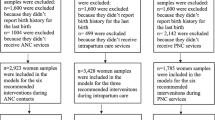Abstract
A combined measure of optimal antenatal care can provide more information on the role it plays in maternal health. Our objectives were to investigate the determinants of a measure of optimal antenatal care and the associated pregnancy outcomes. Data on 7,557 women taken from the 2004 Demographic and Health Survey in Cameroon were used to develop a new measurement of optimal antenatal care based on four indicators: at least four visits, first visit in first trimester, last visit in third trimester and a professional provider of antenatal care. We studied the relationship of this new variable with other related variables in a multivariate analysis, taking into account the complex study design. Almost sixty six percent of the women had optimal antenatal care. Secondary or higher education (OR 1.74; 95% CI 1.28–2.36), greater wealth (OR 2.31; 95% CI 1.73–3.1), urban residence (OR 1.42; 95% CI 1.12–1.82) and parity of 3–4 (OR 0.79; 95% CI 0.62–0.99) were independently associated with optimal antenatal care. Women with optimal antenatal care were more likely to deliver in a health unit (OR 2.91; 95% CI 2.42–3.49), to be assisted by a skilled health worker during delivery (OR 1.88; 95% CI 1.49–2.37) and to have a baby with a normal birthweight (OR 1.62; 95% CI 1.11–2.38). Obtaining and using a new measure for ANC is feasible. The association of optimal antenatal care to education, wealth and residence in this study, consistent with others, highlights the role of the country’s development in maternal health.

Similar content being viewed by others
References
Nawal, M. N. (2008). An introduction to maternal mortality. Reviews in Obstetrics and Gynecology, 1, 77–81.
Bloom, S., Lippeveld, T., & Wypij, D. (1999). Does antenatal care make a difference to safe delivery? A study in urban Uttar Pradesh, India. Health Policy Plan, 14, 38–48.
Abou-Zahr, C., Wardlaw, T. (1990–2001). Antenatal care in developing countries: Promises, achievements and missed opportunities: An analysis of trends, levels and differentials. http://www.childinfo.org/files/antenatal_care.pdf.
United Nations’ Millennium Development Goals. http://www.un.org/millenniumgoals/.
Adekanle, D. A., Isawumi, A. I. (2008). Late antenatal care booking and its predictors among pregnant women in south western Nigeria. Online Journal of Health and Allied Sciences, 7(1), 4. http://www.ojhas.org/issue25/2008-1-4.htm.
Say, L., & Raine, R. (2007). A systematic review of inequalities in the use of maternal health care in developing countries: Examining the scale of the problem and the importance of context. Bulletin of the World Health Organization, 85, 812–819.
Lavender, T., Downe, S., Finnlayson, K., Walsh, D. Access to antenatal care: A systematic Review. http://www.cemach.org.uk/getattachment/dbeebce9-4625-4bbe-bfcd-fec2be076ccc/Access-to-antenatal-care-(Literature-review).aspx.
Downe, S., Finlayson, K., Walsh, D., & Lavender, T. (2009). Weighing up and balancing out: A meta-synthesis of barriers to antenatal care for marginalised women in high-income countries. BJOG, 116, 518–529.
Simkhada, B., Teijlingen, E. R., Porter, M., & Simkhada, P. (2008). Factors affecting the utilization of antenatal care in developing countries: Systematic review of the literature. Journal of Advanced Nursing, 61, 244–260.
Villar, J., Bakketeig, L., Donner, A., Al-Mazrou, Y., Ba’aqeel, H., Belizán, J. M., Carroli, G., Farnot, U., Lumbiganon, P., Piaggio, G., Berendes, H. (1998). The WHO antenatal care randomised controlled trial: Rationale and study design. Paediatric and Perinatal Epidemiology, 12(suppl 2), 27–58.
UNICEF. (2009). State of the world’s children. Maternal and newborn health. http://www.unicef.org/sowc09/report/report.php.
Institut National de la Statistique (INS) et ORC Macro. (2004). Enquête Démographique et de Santé du Cameroun [Cited 2010 July 28]. Available from: http://www.measuredhs.com/aboutsurveys/search/metadata.cfm?surv_id=232&ctry_id=4&SrvyTp=.
WHO Statistical Information System [Online]. (2008). [Cited 2009 July 28]. Available from: http://apps.who.int/whosis/data/Search.jsp?Indicators=[Indicator].[HSR].Members.
Rahman, M., Islam, R., Islam, A. Z. (2008). Rural-urban differentials of utilization of ante-natal health-care services in Bangladesh. Health Policy and Development, 6, 117–125. http://www.bioline.org.br/request?hp08015.
Kotelchuk, M. (1994). An evaluation of the kessner adequacy of prenatal care index and a proposed adequacy of prenatal care utilization index. American Journal of Public Health, 84, 1414–1420.
Measure, D. H. S. (2009). Demographic and health surveys. Survey Methodology. [Online]. [Cited 2009 July 29] Available from: http://www.measuredhs.com/aboutsurveys/methodology/process.cfm.
Showstack, J. A., Budetti, P. P., & Minkler, D. (1984). Factors associated with birthweight: an exploration of the roles of prenatal care and length of gestation. American Journal of Public Health, 74, 1003–1008.
Kotelchuk, M. (1994). The adequacy of prenatal care utilization index: Its US distribution and association with low birthweight. American Journal of Public Health, 84, 1486–1489.
Jimoh, A. A. G. (2003). Utilisation of antenatal services at the provincial hospital, Mongomo, Guinea Equatoria. African Journal of Reproductive Health, 7, 49–54.
Brown, A. C., Sohani, B. S., Khan, K., Lilford, R., & Mukhwana, W. (2008). Antenatal care and perinatal outcomes in Kwale district, Kenya. BMC Pregnancy Childbirth, 8, 2.
Siza, J. E. (2008). Risk factors associated with low birth weight of neonates among pregnant women attending a referral hospital in northern Tanzania. Tanzania Journal of Health Research, 10, 1–8.
Acknowledgements
We are grateful to the Legacy Heritage International Master of Public Health Program and the Hebrew University-Hadassah, Braun School of Public Health and Community Medicine. This work is based on the MPH thesis of Lawrence Mbuagbaw tutored by Rosa Gofin. We are also grateful to Measure DHS for providing us with the 2004 Cameroon DHS data.
Author information
Authors and Affiliations
Corresponding author
Rights and permissions
About this article
Cite this article
Mbuagbaw, L.C.E., Gofin, R. A New Measurement for Optimal Antenatal Care: Determinants and Outcomes in Cameroon. Matern Child Health J 15, 1427–1434 (2011). https://doi.org/10.1007/s10995-010-0707-3
Published:
Issue Date:
DOI: https://doi.org/10.1007/s10995-010-0707-3




